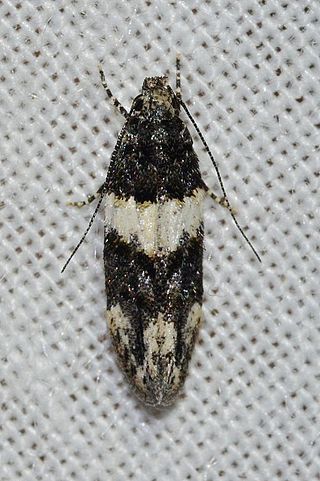
The Bell 212 is a two-blade, twin-engine, medium helicopter that first flew in 1968. Originally manufactured by Bell Helicopter in Fort Worth, Texas, United States, production was moved to Mirabel, Quebec, Canada in 1988, along with all Bell commercial helicopter production after that plant opened in 1986.

Hypena is a genus of moths in the family Erebidae. It was first described by Franz von Paula Schrank in 1802. These non-migratory moths overwinter as pupae and almost never estivate as adults.

Pinna is a genus of bivalve molluscs belonging to the family Pinnidae.

Aulacodes is a genus of moths of the family Crambidae. The genus was first described by Achille Guenée in 1854.

Bradina is a genus of moths of the family Crambidae.

Ugia is a genus of moths in the family Erebidae erected by Francis Walker in 1858.

Dichromia is a genus of moths of the family Erebidae first described by Achille Guenée in 1854.
Xanthomelanopsis is a genus of flies in the family Tachinidae.

Pycnodonte is a genus of extinct oysters, fossil marine bivalve mollusks in the family Gryphaeidae, the foam oysters or honeycomb oysters. Shells of species in this genus are found around the world in fossil shell beds from the Valanginian to the Early Pleistocene. They are a commonly found fossil in Cretaceous shellbeds of the Navesink Formation in New Jersey.

Agrotis vestigialis, the archer's dart, is a moth of the family Noctuidae. The species was first described by Johann Siegfried Hufnagel in 1766. It is found in most of the Palearctic realm from Ireland east, through to Russia, Siberia, the Altai mountains and the Amur region, and is also present in the Mediterranean Basin. It is absent from the north of Finland and Norway.

Strepsinoma croesusalis is a species of moth of the family Crambidae. It was described by Francis Walker in 1859 and is found in Taiwan, China, India and Borneo.

Pelargoderus is a genus of beetle belonging to the family Cerambycidae.
Aulacodes trigonalis is a moth in the family Crambidae. It was described by George Hampson in 1906. It is found in New Guinea.
Bradina trigonalis is a moth in the family Crambidae. It was described by Hiroshi Yamanaka in 1984. It is found in Japan.

Pubitelphusa is a genus of moths in the family Gelechiidae.
Ugia trigonalis is a species of moth in the family Erebidae. It is found in Indonesia (Sumatra).
Oberea trigonalis is a species of longhorn beetle in the tribe Saperdini in the genus Oberea, discovered by Breuning in 1950.

Gigantostrea is an extinct genus of marine bivalve mollusks belonging to the family Gryphaeidae.
Pelargoderus trigonalis is a species of beetle in the family Cerambycidae. It is known from Heyden in 1897.
Ernestokokenia is an extinct genus of mammal, belonging to the Didolodontidae. It lived during the Early Eocene and the Middle Eocene, and its fossils were discovered in South America.












